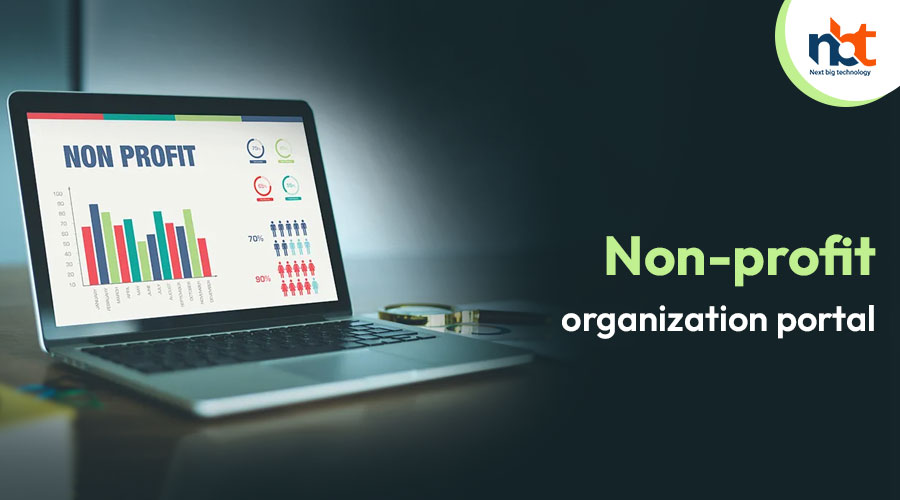Table of Contents
Non-profit organization portal Services
In today’s interconnected world, non-profit organizations play a crucial role in addressing social, environmental, and humanitarian issues. With the advent of technology, these organizations have embraced online platforms to expand their reach, engage with stakeholders, and streamline their operations. Non-profit organization portals offer a myriad of services aimed at enhancing efficiency, transparency, and impact. Let’s delve into the array of services these portals provide:
- Donation Management: Non-profit organization portals facilitate seamless donation management, allowing supporters to contribute funds securely. These portals often feature customizable donation forms, enabling organizations to collect donations for specific projects or campaigns. Moreover, they provide donors with receipts and acknowledgments, fostering trust and transparency.
- Volunteer Coordination: Volunteers are the lifeblood of many non-profit organizations. Portals offer robust volunteer management systems, where individuals can sign up for opportunities, track their hours, and communicate with organizers. This streamlines the process of recruiting, scheduling, and recognizing volunteers, maximizing their impact.
- Program and Project Management: Non-profit portals serve as central hubs for managing programs and projects. Organizations can outline objectives, allocate resources, and track progress in real-time. This enables efficient collaboration among team members, donors, and beneficiaries, ensuring that initiatives stay on track and deliver measurable outcomes.
- Event Planning and Promotion: Whether it’s a fundraising gala, awareness campaign, or community event, non-profit portals simplify event planning and promotion. From creating event pages and managing registrations to promoting events through social media integration, these portals help organizations attract attendees and maximize participation.
- Resource Sharing and Collaboration: Collaboration is key to driving meaningful change. Non-profit portals facilitate collaboration by providing shared workspaces, document repositories, and communication tools. This fosters collaboration among staff, volunteers, partners, and stakeholders, enabling knowledge sharing and collective problem-solving.
- Impact Measurement and Reporting: Non-profit organizations are accountable to their donors, supporters, and the communities they serve. Portals offer robust tools for tracking and measuring impact, allowing organizations to collect data, analyze results, and generate comprehensive reports. This transparency builds credibility and enables organizations to demonstrate their effectiveness.
- Communication and Engagement: Effective communication is essential for building relationships and mobilizing support. Non-profit portals offer various communication channels, including newsletters, blogs, forums, and social media integration. This enables organizations to engage with stakeholders, share updates, and solicit feedback, fostering a sense of community and belonging.
- Grant and Fundraising Management: Securing funding is vital for sustaining non-profit operations and advancing their missions. Portals streamline the grant and fundraising process by providing tools for grant research, proposal writing, and donor management. This enhances organizations’ ability to identify funding opportunities, cultivate relationships with donors, and diversify their revenue streams.
How to Create a Non-profit organization portal
In the realm of non-profit organizations, having a well-designed and functional online portal can be a game-changer. Not only does it facilitate smoother operations and communication within the organization, but it also enhances engagement with stakeholders and donors. If you’re considering creating a portal for your non-profit organization, here’s a comprehensive guide to help you get started.
- Define Your Objectives: Before diving into the technical aspects of building a portal, it’s crucial to define your objectives clearly. What do you aim to achieve with the portal? Are you looking to streamline volunteer management, increase donor engagement, or improve communication among team members? Understanding your goals will guide the development process and ensure that the portal aligns with your organization’s mission.
- Choose the Right Platform: Selecting the appropriate platform for your non-profit organization portal is paramount. There are various options available, ranging from custom-built solutions to off-the-shelf software. Consider factors such as cost, scalability, ease of use, and integration capabilities when making your decision. Popular choices include WordPress, Drupal, and Joomla for content management, while platforms like Salesforce and Blackbaud offer specialized solutions for non-profits.
- Design a User-Friendly Interface: The user experience (UX) of your portal plays a significant role in its effectiveness. Ensure that the interface is intuitive and easy to navigate for all users, including volunteers, donors, and staff members. Incorporate clear calls-to-action and organize content logically to facilitate seamless interactions. Responsive design is essential to ensure accessibility across various devices and screen sizes.
- Implement Essential Features: Identify the essential features and functionalities that your non-profit organization portal requires. These may include:
- Volunteer Management System: A module to recruit, schedule, and track volunteers’ activities.
- Donation Processing: Secure payment gateway integration for accepting online donations.
- Event Management: Tools to promote, register, and manage fundraising events and campaigns.
- Communication Tools: Email newsletters, discussion forums, and messaging systems to foster community engagement.
- Reporting and Analytics: Insights into website traffic, donor behavior, and campaign performance to inform decision-making.
- Customize for Branding and Identity: Your portal should reflect your organization’s branding and identity to create a cohesive online presence. Customize the design elements such as colors, fonts, and logos to align with your brand guidelines. Consistency in branding builds trust and reinforces your organization’s credibility.
- Ensure Security and Compliance: Security is paramount when handling sensitive data such as donor information and financial transactions. Implement robust security measures, including SSL encryption, firewall protection, and regular software updates, to safeguard against cyber threats. Additionally, ensure compliance with relevant regulations, such as GDPR for data protection and PCI DSS for payment processing.
- Provide Training and Support: Empower your team members with the necessary training and resources to utilize the portal effectively. Offer tutorials, user guides, and ongoing support to address any queries or issues they may encounter. Investing in training upfront can enhance user adoption and maximize the portal’s impact on your organization’s operations.
- Continuously Evaluate and Improve: The development of your non-profit organization portal doesn’t end once it’s launched. Regularly evaluate its performance and gather feedback from users to identify areas for improvement. Monitor key metrics such as engagement levels, donation trends, and volunteer participation to assess the portal’s effectiveness. Iterate and refine the portal based on insights gleaned from data analysis and user input.
Why Should You Go for Non-profit organization portal
In today’s fast-paced world, the need for altruism and community engagement has never been more apparent. Non-profit organizations (NPOs) play a crucial role in addressing societal issues and driving positive change. However, managing the operations of an NPO efficiently can be a daunting task without the right tools and resources. This is where non-profit organization portals come into play, offering a myriad of benefits for both NPOs and their stakeholders.
- Streamlined Communication: One of the key advantages of non-profit organization portals is the ability to streamline communication. These portals provide a centralized platform where members, volunteers, donors, and beneficiaries can easily connect and collaborate. Whether it’s sharing updates, coordinating events, or seeking support, a well-designed portal facilitates seamless communication among all stakeholders.
- Efficient Resource Management: NPOs often operate on limited resources, making efficient resource management essential for their sustainability. Non-profit organization portals offer robust features for managing donations, volunteer hours, and other resources effectively. From tracking donations in real-time to scheduling volunteer shifts, these portals empower NPOs to make the most of their available resources.
- Transparency and Accountability: Transparency and accountability are paramount in the non-profit sector, where trust is key to garnering support. Non-profit organization portals enable NPOs to maintain transparency by providing stakeholders with access to relevant information such as financial reports, impact metrics, and project updates. This transparency fosters trust and confidence among donors and supporters, ultimately strengthening the organization’s reputation.
- Enhanced Engagement: Engaging stakeholders is essential for the success of any non-profit organization. Non-profit organization portals offer various features to enhance stakeholder engagement, such as discussion forums, event calendars, and personalized communication channels. By providing a platform for interaction and participation, these portals foster a sense of community and belonging among members and supporters.
- Data-driven Decision Making: In today’s data-driven world, the ability to gather and analyze data is invaluable. Non-profit organization portals often include built-in analytics tools that allow NPOs to track key metrics, measure impact, and make informed decisions. Whether it’s evaluating the effectiveness of fundraising campaigns or assessing program outcomes, data-driven insights empower NPOs to optimize their strategies and maximize their impact.
- Cost-effectiveness: Contrary to popular belief, implementing a non-profit organization portal doesn’t have to be prohibitively expensive. Many providers offer affordable solutions tailored to the specific needs and budgets of NPOs. Moreover, the long-term benefits of improved efficiency, increased transparency, and enhanced engagement far outweigh the initial investment, making non-profit organization portals a cost-effective solution in the long run.
Market Prospects of Non-profit organization portal and Platforms
In recent years, the landscape of non-profit organizations has undergone a significant transformation, with technology playing a pivotal role in amplifying their impact and reach. With the rise of non-profit organization portals and platforms, these entities now have powerful tools at their disposal to streamline operations, enhance transparency, and engage stakeholders effectively. In this article, we delve into the market prospects of these platforms and their potential to drive positive change in the non-profit sector.
- Increased Accessibility and Visibility: Non-profit organization portals and platforms serve as centralized hubs where supporters, volunteers, and donors can easily access information about various causes and initiatives. This increased accessibility translates to greater visibility for non-profits, allowing them to attract a broader audience and garner support for their missions. As more individuals seek convenient ways to engage with social causes, the demand for user-friendly platforms is poised to rise.
- Efficient Resource Management: Managing resources efficiently is paramount for non-profits to maximize their impact. Modern portals and platforms offer features such as donation tracking, volunteer management, and project monitoring, enabling organizations to allocate resources effectively and measure outcomes accurately. As donors increasingly prioritize transparency and accountability, non-profits equipped with robust management tools stand to gain a competitive edge in the market.
- Collaboration and Networking Opportunities: Collaboration is central to the success of non-profit organizations, as partnerships enable them to pool resources, share expertise, and amplify their collective impact. Portals and platforms facilitate seamless collaboration by connecting organizations with similar goals and facilitating knowledge sharing and best practices. This collaborative environment fosters innovation and allows non-profits to tackle complex social challenges more effectively.
- Data-driven Decision Making: In the digital age, data has become a valuable asset for non-profits seeking to understand their impact and refine their strategies. Advanced analytics tools integrated into portals and platforms provide organizations with actionable insights into donor behavior, campaign performance, and societal trends. By leveraging data-driven decision-making, non-profits can optimize their operations, target their outreach efforts more effectively, and demonstrate measurable results to stakeholders.
- Adaptability to Changing Needs: The non-profit landscape is constantly evolving, with new challenges emerging and existing ones evolving. Portals and platforms equipped with flexible architectures and modular functionalities can adapt to changing needs and accommodate emerging trends in the sector. Whether it’s incorporating emerging fundraising models, integrating emerging technologies like blockchain for enhanced transparency, or addressing new societal issues, adaptable platforms ensure that non-profits remain relevant and responsive to the evolving landscape.
- Potential Challenges and Considerations: While the market prospects for non-profit organization portals and platforms are promising, several challenges warrant consideration. These include data privacy concerns, cybersecurity risks, ensuring inclusivity and accessibility, and the need for sustainable funding models. Addressing these challenges requires collaboration between technology providers, non-profit organizations, policymakers, and other stakeholders to create a supportive ecosystem that fosters innovation while safeguarding the interests of all parties involved.
Essential Features of a Non-profit organization portal
In today’s digital age, non-profit organizations are harnessing the power of technology to streamline operations, engage stakeholders, and drive their mission forward. A well-designed non-profit organization portal serves as a central hub for communication, collaboration, and resource management. From fundraising to volunteer coordination, these portals play a crucial role in enhancing organizational efficiency and impact.
Here are some essential features that every non-profit organization portal should incorporate:
- User-Friendly Interface: The portal should have an intuitive interface that is easy to navigate for both administrators and users. Clear menus, logical layout, and responsive design ensure accessibility across devices.
- Donation Management: An effective donation management system allows for secure online donations, tracking donor information, and generating tax receipts. Integration with popular payment gateways ensures convenience and trust for donors.
- Volunteer Management: Streamline volunteer recruitment, scheduling, and communication through dedicated volunteer management tools. Volunteers should be able to sign up for opportunities, track their hours, and receive updates on upcoming events.
- Event Management: Organize and promote fundraising events, workshops, and community gatherings through the portal. Features such as event registration, ticket sales, and attendee management simplify event planning and execution.
- Content Management System (CMS): A robust CMS enables administrators to update content, publish news articles, and share success stories without technical expertise. Regularly updated content keeps stakeholders informed and engaged.
- Member Directory and Profiles: Maintain a database of members, donors, and stakeholders with customizable profiles. Access to contact information, donation history, and engagement metrics facilitates personalized communication and relationship-building.
- Reporting and Analytics: Track key performance indicators (KPIs), such as donation trends, volunteer participation, and website traffic, through comprehensive reporting and analytics tools. Data-driven insights inform strategic decision-making and demonstrate impact to stakeholders.
- Secure Access Controls: Implement robust security measures to protect sensitive data and ensure compliance with privacy regulations. Role-based access controls (RBAC) limit access to authorized users and safeguard confidential information.
- Integration with Third-Party Platforms: Seamless integration with email marketing tools, social media platforms, and CRM systems enhances communication and expands outreach efforts. Automated workflows streamline data synchronization and eliminate manual tasks.
- Mobile App Compatibility: With the increasing use of smartphones, a mobile-responsive design or dedicated mobile app extends accessibility to users on the go. Mobile-friendly features, such as push notifications and mobile donations, enhance user engagement and convenience.
Advanced Features Non-profit organization portal
In the digital age, non-profit organizations are increasingly turning to online platforms to streamline their operations, engage with donors and volunteers, and amplify their impact. A well-designed non-profit organization portal can serve as a central hub for managing donations, coordinating events, and communicating with stakeholders. However, to truly maximize the potential of these portals, it’s essential to leverage advanced features that enhance functionality, improve user experience, and drive meaningful outcomes.
Here, we explore some advanced features that can take your non-profit organization portal to the next level:
- Customizable Donation Forms: Simplify the donation process by offering customizable donation forms that allow donors to specify the purpose of their donation, set up recurring donations, and even dedicate their contribution in honor or memory of a loved one. Providing flexibility in donation options can encourage greater participation and support.
- Integrated Fundraising Campaigns: Seamlessly integrate fundraising campaigns into your portal, allowing supporters to create personalized fundraising pages, track progress towards fundraising goals, and share their campaigns on social media. By empowering supporters to become advocates for your cause, you can extend your reach and inspire others to get involved.
- Volunteer Management Tools: Streamline volunteer recruitment, scheduling, and communication with built-in volunteer management tools. Enable volunteers to sign up for specific opportunities, track their hours, and receive updates on upcoming events. By making it easier for volunteers to get involved, you can cultivate a dedicated community of supporters who are committed to your organization’s mission.
- Event Registration and Ticketing: Organize and promote events directly through your portal with integrated event registration and ticketing functionality. Allow attendees to register online, purchase tickets, and access event details, all in one convenient location. Advanced features such as QR code ticketing and attendee check-in can enhance the event experience for both organizers and participants.
- Donor Relationship Management (CRM): Implement a donor relationship management system within your portal to effectively track and steward donor relationships. Capture donor information, record interactions, and segment donors based on their giving history and preferences. By personalizing communication and stewardship efforts, you can strengthen donor loyalty and maximize donor lifetime value.
- Impact Reporting and Transparency: Demonstrate the impact of your organization’s work through interactive dashboards, real-time reporting, and transparent financial data. Provide donors and stakeholders with visibility into how their contributions are making a difference, including metrics such as funds raised, projects completed, and beneficiaries served. By fostering transparency and accountability, you can build trust and credibility with your supporters.
- Integration with External Platforms: Connect your non-profit organization portal with external platforms and services, such as email marketing tools, social media channels, and payment gateways. Seamless integration enables data synchronization, cross-platform communication, and automation of routine tasks, ultimately saving time and resources for your organization.
Non-profit organization portal Timelines
In the realm of non-profit organizations, effective management and communication are paramount. With the advent of technology, non-profits have embraced online portals as invaluable tools for enhancing efficiency and transparency. Navigating these portals efficiently requires a clear understanding of their timelines, which dictate crucial milestones and activities. In this article, we delve into the timelines associated with non-profit organization portals, providing a comprehensive guide for stakeholders.
Understanding Non-Profit Organization Portals: Non-profit organization portals serve as centralized platforms for managing various aspects of operations, including fundraising, volunteer coordination, program management, and reporting. These portals are designed to streamline processes, facilitate collaboration, and enhance communication among stakeholders, including staff, volunteers, donors, and beneficiaries.
Key Timelines:
- Development and Launch:
- Planning Phase: This stage involves outlining portal objectives, identifying key features, and selecting a suitable platform.
- Development Phase: Developers work on building and customizing the portal according to the organization’s needs and specifications.
- Testing and Feedback: Beta testing is conducted to identify bugs and gather feedback from users for refinement.
- Launch: The portal is officially launched, accompanied by training sessions for users to familiarize themselves with its functionalities.
- Onboarding and Training:
- Staff Onboarding: New staff members are introduced to the portal and trained on how to navigate its features for their respective roles.
- Volunteer Training: Volunteers receive orientation and training on using the portal to sign up for opportunities, track their hours, and communicate with staff.
- User Support: Ongoing support is provided to address user queries and ensure smooth navigation of the portal.
- Fundraising Campaigns:
- Pre-Campaign Preparation: Planning and preparation phase, including setting fundraising goals, creating campaign content, and building donor lists.
- Campaign Launch: The campaign goes live on the portal, accompanied by marketing efforts to promote it to potential donors.
- Donation Tracking: Real-time tracking of donations and progress towards fundraising goals, with regular updates for donors.
- Post-Campaign Evaluation: Analysis of campaign performance, including funds raised, donor engagement, and areas for improvement.
- Program Management:
- Program Planning: Development of program goals, objectives, and activities, with timelines outlined on the portal.
- Participant Registration: Participants register for programs through the portal, providing necessary information and waivers.
- Program Monitoring: Tracking attendance, collecting feedback, and assessing program impact through the portal’s reporting tools.
- Program Evaluation: Analysis of program outcomes and effectiveness based on data collected through the portal.
- Reporting and Compliance:
- Data Collection: Regular input of data into the portal regarding financial transactions, program outcomes, and organizational metrics.
- Report Generation: Generation of reports for stakeholders, including board members, donors, and regulatory authorities, using data stored in the portal.
- Compliance Checks: Ensuring compliance with legal and regulatory requirements by maintaining accurate records and documentation within the portal.
How Much Does It Cost to Build a Non-profit organization portal?
In the digital age, establishing an online presence is crucial for non-profit organizations to reach wider audiences, engage supporters, and efficiently manage operations. However, embarking on the journey to create a non-profit organization portal requires careful consideration of various factors, including budgetary constraints. So, how much does it actually cost to build such a portal?
- Website Design and Development: The cornerstone of any online presence is a well-designed and functional website. Costs for website design and development can vary significantly based on complexity, features, and the agency or freelancer hired for the job. For a basic non-profit organization portal, expect to allocate anywhere from $2,000 to $10,000. More complex portals with custom features such as donation processing, volunteer management systems, or event registration functionalities can range from $10,000 to $50,000 or more.
- Domain and Hosting: Securing a domain name (the web address) and hosting services (where your website files are stored) are ongoing expenses for any website. Domain registration typically costs around $10 to $20 per year, while hosting can range from $100 to $500 annually depending on the provider and server resources required.
- Content Management System (CMS): Choosing the right CMS is crucial for efficiently managing and updating website content. Popular options like WordPress, Joomla, or Drupal offer varying levels of customization and scalability. While some CMS platforms are open-source and free to use, costs may arise from premium themes, plugins, or hiring developers for customization. Budget around $500 to $2,000 for CMS setup and customization.
- Security and Maintenance: Maintaining the security and functionality of your non-profit portal is an ongoing commitment. Investing in security measures such as SSL certificates, regular software updates, and backups is essential to protect sensitive data and ensure smooth operations. Budget around $500 to $2,000 annually for security and maintenance services.
- Integration with Third-Party Services: Non-profit organizations often rely on third-party services for fundraising, email marketing, or volunteer management. Integrating these services into your portal may incur additional costs, either through subscription fees or custom development work. Budget accordingly based on the specific services required.
- Training and Support: Providing training for staff or volunteers responsible for managing the portal is essential for long-term success. Factor in costs for training sessions or hiring consultants to ensure users are proficient in utilizing the portal’s features effectively.
- Accessibility and Compliance: Ensuring your portal is accessible to all users, including those with disabilities, is not only a moral imperative but also a legal requirement in many jurisdictions. Budget for accessibility audits and remediation efforts to ensure compliance with relevant regulations such as the Americans with Disabilities Act (ADA).
How to Create a Non-profit organization portal – Team and Tech Stack
Creating a non-profit organization portal requires careful planning, dedication, and a solid team with the right technical expertise. In this guide, we’ll explore the essential steps to take and the key elements to consider when forming your team and selecting the appropriate tech stack for your non-profit organization’s portal.
- Define Your Goals and Objectives: Before assembling your team or selecting the technology stack, it’s crucial to clearly define the goals and objectives of your non-profit organization portal. Determine what you aim to achieve with the portal, whether it’s raising awareness, facilitating donations, volunteer management, or providing resources to your target audience.
- Build Your Team: Creating a successful non-profit organization portal requires a diverse team with various skills and expertise. Here are some key roles to consider:
- Project Manager: Oversees the entire development process, ensures deadlines are met, and keeps the project on track.
- Web Developer: Responsible for building and maintaining the technical infrastructure of the portal.
- UI/UX Designer: Designs the user interface and ensures a seamless and intuitive user experience.
- Content Creator: Develops compelling content for the portal, including written copy, graphics, and multimedia elements.
- Marketing Specialist: Promotes the portal to increase visibility and attract users, donors, and volunteers.
- Legal Advisor: Ensures compliance with relevant regulations and helps navigate legal issues related to the portal.
- Selecting the Right Technology Stack: Choosing the appropriate technology stack is essential for the successful development and operation of your non-profit organization portal. Consider the following factors when selecting your tech stack:
- Scalability: Ensure that the technology stack can accommodate growth and handle increased traffic as your organization expands.
- Security: Protect sensitive data and ensure compliance with data protection regulations by choosing secure technologies and implementing robust security measures.
- Ease of Use: Select technologies that are user-friendly and easy to maintain, allowing your team to focus on achieving your organization’s mission rather than wrestling with complex technical issues.
- Cost-effectiveness: Consider the budget constraints of your non-profit organization and choose technologies that offer the best value for money without compromising on quality or functionality.
- Implementing and Maintaining the Portal: Once you’ve assembled your team and selected your technology stack, it’s time to begin development and implementation. Work closely with your team to build and launch the portal, and continue to monitor its performance and gather feedback from users.
Regular maintenance and updates are essential to keep your non-profit organization portal running smoothly and ensure that it continues to meet the needs of your target audience.
Non-profit organization portal Process
In the digital age, non-profit organizations are leveraging technology to streamline their operations, engage with stakeholders, and amplify their impact. One such innovation is the creation of a dedicated non-profit organization portal. This centralized platform serves as a hub for communication, fundraising, volunteer management, and program delivery, offering numerous benefits for both the organization and its constituents.
Understanding the Need: Before delving into the process of creating a non-profit organization portal, it’s crucial to grasp why such a platform is essential. Non-profits operate in a complex landscape, often with limited resources and manpower. A portal provides a unified solution to manage various aspects of their work efficiently.
Defining Objectives and Requirements: The first step in developing a non-profit organization portal is to define clear objectives and requirements. This involves conducting a thorough needs assessment to understand the specific challenges and opportunities faced by the organization. Whether it’s enhancing donor engagement, improving volunteer coordination, or centralizing program information, identifying key priorities is essential.
Selecting the Right Platform: With objectives in place, the next step is to choose the appropriate platform for building the portal. Factors such as cost, scalability, customization options, and ease of use should be considered. Many non-profits opt for user-friendly Content Management Systems (CMS) like WordPress or Drupal, while others may prefer bespoke solutions developed by software vendors.
Design and Development: Once the platform is selected, the design and development phase begins. The portal’s layout, functionality, and user experience are critical considerations during this stage. The design should be intuitive, accessible, and reflective of the organization’s brand identity. Collaboration between designers, developers, and stakeholders ensures that the final product meets expectations.
Integration and Data Migration: For many non-profits, integrating the portal with existing systems and migrating data from legacy platforms is a complex task. Whether it’s integrating with a Customer Relationship Management (CRM) system for donor management or migrating volunteer databases, careful planning and execution are essential to ensure a smooth transition.
Testing and Feedback: Before launching the portal to the public, thorough testing is necessary to identify and resolve any bugs or usability issues. User feedback should also be solicited to gather insights for further improvements. Conducting beta tests with a select group of users can provide valuable feedback and help fine-tune the portal for broader deployment.
Training and Deployment: With testing complete and feedback incorporated, the final step is to train staff and stakeholders on using the portal effectively. Training sessions should cover navigation, functionality, and best practices for maximizing the portal’s potential. Once everyone is comfortable with the platform, it can be officially deployed for use.
Next Big Technology – Your Trusted Non-profit organization portal Partner
In the dynamic landscape of the digital era, non-profit organizations are increasingly recognizing the significance of harnessing technology to amplify their impact and reach. As they strive to fulfill their missions and serve their communities, the partnership with a trusted technology portal emerges as a game-changer. In this article, we delve into the transformative potential of collaborating with the Next Big Technology Portal as your trusted non-profit organization partner.
Embracing Innovation: Innovation lies at the heart of progress, and non-profits are no exception. By partnering with the Next Big Technology Portal, non-profit organizations gain access to cutting-edge solutions tailored to their specific needs. Whether it’s streamlining operations, enhancing fundraising efforts, or improving outreach and communication, innovative technological tools empower non-profits to operate more efficiently and effectively.
Streamlined Operations: The Next Big Technology Portal offers a suite of user-friendly software and platforms designed to streamline organizational processes. From project management tools to volunteer coordination platforms, these solutions simplify administrative tasks, allowing non-profits to focus their time and resources on advancing their core missions. By automating routine workflows and centralizing data management, non-profits can optimize their operations and drive greater impact.
Enhanced Fundraising: Fundraising is essential for the sustainability of non-profit organizations, and technology has revolutionized the way they engage donors and raise funds. Through the Next Big Technology Portal, non-profits gain access to innovative fundraising platforms, donor management systems, and online giving tools. These solutions enable non-profits to reach a wider audience, personalize their fundraising campaigns, and cultivate long-term relationships with donors, ultimately increasing their financial support.
Improved Outreach and Communication: Effective communication is key to building awareness, fostering community engagement, and mobilizing support for non-profit causes. By partnering with the Next Big Technology Portal, non-profits can leverage advanced communication tools such as email marketing platforms, social media management software, and website development resources. These tools empower non-profits to share their stories, connect with stakeholders, and inspire action, amplifying their impact and influence.
Data-driven Decision Making: In today’s data-driven world, insights gleaned from data analysis are invaluable for informed decision-making. The Next Big Technology Portal provides non-profits with access to powerful analytics tools that enable them to track and measure their impact, assess program effectiveness, and identify areas for improvement. By harnessing the power of data, non-profits can continuously refine their strategies, allocate resources more efficiently, and maximize their social impact.
Building Community and Collaboration: Collaboration is at the heart of the non-profit sector, and the Next Big Technology Portal facilitates greater collaboration among organizations, volunteers, donors, and beneficiaries. Through online collaboration platforms, virtual networking events, and knowledge-sharing resources, non-profits can connect with like-minded partners, share best practices, and collectively tackle complex challenges. By fostering a sense of community and collaboration, the Next Big Technology Portal empowers non-profits to achieve greater collective impact.
Enterprise Non-profit organization portal
In the realm of non-profit organizations, efficiency, transparency, and streamlined operations are paramount. These entities, driven by noble causes and dedicated to serving communities, often face significant challenges in managing their resources, volunteers, and initiatives effectively. Enter the Enterprise Non-profit Organization Portal – a game-changer in the landscape of non-profit management.
Understanding the Need
Non-profit organizations, regardless of their size or mission, grapple with a myriad of administrative tasks. From donor management to volunteer coordination, program tracking to financial reporting, the array of responsibilities can overwhelm even the most dedicated teams. Traditionally, managing these tasks involved disparate systems, spreadsheets, and manual processes, leading to inefficiencies, errors, and frustration.
The Enterprise Portal Solution
Enter the Enterprise Non-profit Organization Portal – a comprehensive, centralized platform designed to address the unique needs and challenges of non-profit management. This sophisticated solution integrates various functionalities into a single, user-friendly interface, empowering organizations to streamline their operations and maximize their impact.
Key Features:
- Donor Management: Centralizing donor information, tracking contributions, and managing fundraising campaigns are made seamless with the portal’s intuitive donor management system. From generating acknowledgment letters to analyzing donor trends, organizations gain invaluable insights to nurture relationships and drive fundraising efforts.
- Volunteer Coordination: Effectively mobilizing volunteers is crucial for non-profit success. The portal simplifies volunteer recruitment, scheduling, and communication, ensuring that organizations have the right people in the right place at the right time. Volunteer profiles, shift management, and automated reminders enhance efficiency and engagement.
- Program Tracking: Tracking program outcomes, participant data, and impact metrics is essential for demonstrating accountability and measuring success. The portal facilitates real-time monitoring of programs, enabling organizations to assess performance, identify areas for improvement, and report outcomes to stakeholders with confidence.
- Financial Management: Managing finances with transparency and accuracy is fundamental for non-profit credibility. The portal’s robust financial management tools streamline budgeting, expense tracking, and grant management, facilitating compliance with regulatory requirements and enhancing accountability to donors and governing bodies.
- Collaboration and Communication: Effective collaboration is key to non-profit efficiency. The portal fosters collaboration among staff, volunteers, and stakeholders through shared calendars, document repositories, and communication channels. Real-time updates and notifications keep everyone informed and aligned, driving synergy and cohesion across the organization.
Benefits:
- Enhanced Efficiency: By consolidating disparate processes into a unified platform, the portal eliminates duplication of efforts, reduces manual workload, and accelerates task completion, freeing up valuable time and resources for mission-critical activities.
- Improved Transparency: Transparent operations build trust and confidence among stakeholders. The portal provides stakeholders with real-time access to information, reports, and metrics, fostering transparency and accountability at every level of the organization.
- Greater Impact: By optimizing resource allocation, improving program effectiveness, and enhancing stakeholder engagement, the portal empowers non-profit organizations to amplify their impact and achieve their mission with greater efficacy and sustainability.
Top Non-profit organization portal Companies
In the ever-evolving landscape of non-profit organizations, technology has become an indispensable tool for driving efficiency, transparency, and impact. Non-profit organization portal companies play a pivotal role in this regard, offering platforms and solutions tailored to the unique needs of these organizations. Let’s delve into some of the top players in this space, revolutionizing the way non-profits operate and fulfill their missions.
-
-
Next Big Technology:
Next Big Technology is one of the top development companies for the high-quality development of mobile apps and web development services. They have having experienced in-house team of developers who provide top-notch development services according to the business requirements. NBT provides highly business-oriented services and implements all the latest and trending tools and technologies. They always work hard to deliver a top-notch solution at an affordable cost. They are having experience of more than 13 years and delivered lots of projects around the globe to businesses and clients.
NBT is highly focused on providing top-notch development solutions at a very affordable cost. By using their market experience and development experience, they are delivering proper solutions to clients and various industries for their custom requirements.
Location: India, USA, UK, Australia
Hourly Rate :< $25 per Hour
Employees: 50 – 249
Focus Area
- Mobile App Development
- App Designing (UI/UX)
- Software Development
- Web Development
- AR & VR Development
- Big Data & BI
- Cloud Computing Services
- DevOps
- E-commerce Development
Industries Focus
- Art, Entertainment & Music
- Business Services
- Consumer Products
- Designing
- Education
- Financial & Payments
- Gaming
- Government
- Healthcare & Medical
- Hospitality
- Information Technology
- Legal & Compliance
- Manufacturing
- Media
-
- Blackbaud: Blackbaud has been a leader in providing software and services to the social good community for decades. Their solutions, including Raiser’s Edge NXT and Luminate Online, offer comprehensive tools for fundraising, donor management, and marketing. Blackbaud’s commitment to innovation and customer success makes them a trusted partner for non-profits worldwide.
- Classy: Classy is a fundraising platform that caters specifically to non-profit organizations. Their user-friendly interface makes it easy for organizations to create compelling campaigns, manage donations, and engage supporters. With features like peer-to-peer fundraising and event management, Classy empowers non-profits to leverage the power of online fundraising effectively.
- DonorPerfect: DonorPerfect provides cloud-based fundraising and donor management software for non-profits of all sizes. Their robust platform includes tools for donor cultivation, online fundraising, and reporting. With customizable features and integrations with other software solutions, DonorPerfect offers flexibility and scalability to meet the unique needs of each organization.
- NeonCRM: NeonCRM offers a comprehensive solution for non-profit management, including donor management, event registration, and membership tracking. Their platform is highly customizable, allowing organizations to tailor it to their specific workflows and requirements. With built-in analytics and communication tools, NeonCRM enables non-profits to make data-driven decisions and engage with their supporters effectively.
- EveryAction: EveryAction provides a unified platform for non-profit fundraising, advocacy, and donor management. Their suite of tools includes features like email marketing, online donations, and advocacy campaigns. EveryAction’s intuitive interface and robust functionality make it a popular choice for non-profits looking to maximize their impact and drive social change.
- Bloomerang: Bloomerang offers donor management software focused on donor retention and engagement. Their platform helps non-profits build stronger relationships with donors through personalized communication and targeted outreach. With features like donor loyalty scores and task management, Bloomerang equips organizations with the tools they need to cultivate long-term support.
FAQs on Non-profit organization portal
Non-profit organizations play a crucial role in serving communities, championing causes, and driving positive change. In the digital age, having an effective online presence is paramount for these organizations to connect with stakeholders, donors, and volunteers. Non-profit organization portals serve as a centralized hub for information, resources, and engagement opportunities. In this article, we’ll delve into frequently asked questions (FAQs) surrounding non-profit organization portals to help you navigate and optimize your online presence.
- What is a non-profit organization portal? A non-profit organization portal is a web-based platform designed to serve as a central hub for all activities related to a non-profit organization. It typically includes features such as information about the organization’s mission and programs, donation processing, volunteer sign-ups, event management, and resources for stakeholders.
- Why is having a portal important for non-profit organizations? Having a portal for your non-profit organization is essential for several reasons:
- Centralized Information: It provides a centralized location for stakeholders to access information about the organization, its initiatives, and how they can get involved.
- Enhanced Engagement: Portals facilitate engagement with donors, volunteers, and beneficiaries through features like donation processing, volunteer sign-ups, and event registration.
- Transparency: A well-designed portal promotes transparency by providing insights into the organization’s finances, impact, and governance structure.
- Fundraising: It streamlines the donation process, making it easier for supporters to contribute financially to the organization’s cause.
- What features should a non-profit organization portal have? While the specific features may vary based on the organization’s needs, some essential features of a non-profit organization portal include:
- Donation Processing: Secure and user-friendly donation processing capabilities to accept online contributions.
- Volunteer Management: Tools for volunteer recruitment, scheduling, and communication.
- Event Management: Functionality for promoting and managing fundraising events, workshops, and other activities.
- Resource Center: A repository of resources, reports, and educational materials related to the organization’s mission and programs.
- News and Updates: Regularly updated news section or blog to keep stakeholders informed about the organization’s latest developments.
- Social Media Integration: Integration with social media platforms to amplify the organization’s reach and engagement.
- How can non-profit organizations optimize their portals for search engines (SEO)? Optimizing a non-profit organization portal for search engines can enhance its visibility and attract more visitors. Some SEO best practices include:
- Keyword Research: Identify relevant keywords related to your organization’s mission, programs, and target audience.
- On-Page Optimization: Optimize page titles, meta descriptions, headers, and content with targeted keywords.
- Quality Content: Regularly publish high-quality, informative content that resonates with your audience and addresses their needs.
- Mobile Optimization: Ensure that the portal is mobile-friendly to provide a seamless user experience across devices.
- Link Building: Build inbound links from reputable websites to improve your portal’s authority and search engine rankings.
- Analytics Tracking: Use analytics tools to monitor website traffic, user behavior, and performance metrics to make data-driven improvements.
Thanks for reading our post “Non-profit organization portal”. Please connect with us to learn more about the Non-profit organization.

























